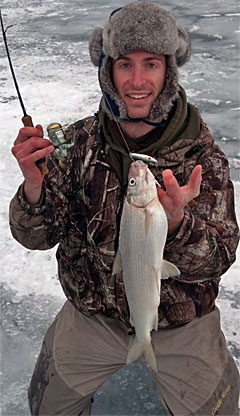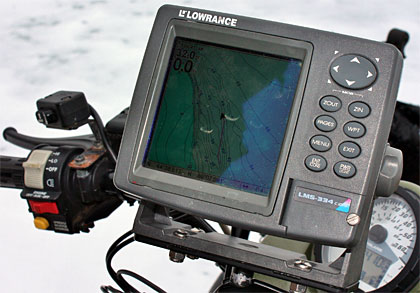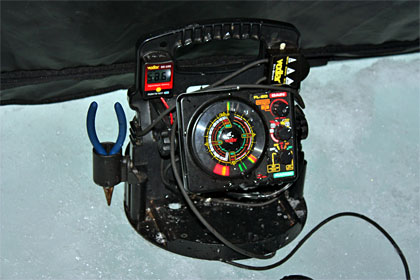

By Jeff Nedwick on Feb 13, 2015 with Comments 0

Winter is one of the best times to catch Crystal Lake whitefish – like this one caught by ice angler Andrew Joseph Brunner of Traverse City while jigging deep mud flats. Photo Credit: Andrew Joseph Brunner
By mid-winter, even the most dedicated, die-hard ice anglers start to wear down. Thick ice and deep snow make getting to and from spots difficult but do nothing to stem the crowds of panfish anglers on popular Great Lakes area waters. The panfish and walleye bite has slowed – the fish seemingly in a slumber, hunkered down in relatively highly-oxygenated main lake basins.
When the panfish ice-bite slows, it’s time for a change of venue to break free of the mid-winter doldrums. It’s time for a whitefish ice fishing road trip.
One of the best places to catch these tasty and feisty deep water denizens is Crystal Lake; a pristine 10,000 acre body of water located about 25 miles southwest of Traverse City.
Crystal Lake features depths below 150 feet and has an average depth of 70 feet but there’s also plenty of shallow, fertile habitat, making it a classic “two-stage” lake, hosting healthy populations of warm water species like perch, walleye and smallmouth bass as well as cold water species like lake trout, burbot and whitefish. Of course winter is the great equalizer – where all water is cold water and the favored habitats of warm and cold water species overlap making it fairly common to catch perch, whitefish and lake trout from the same hole on a given day.
But it’s whitefish that draws most anglers to Crystal Lake in the winter – anglers like Dan Zatarga of nearby Bear Lake, Michigan. Zatarga – a retired school teacher and current member of Mark Martin’s pro staff – spends winters here chasing schools of the three to five pound whitefish.

Fishing electronics, like a good GPS unit, play a key role in locating areas where whitefish feed. Photo Credit: Jeff Nedwick
Zatarga says the key to finding whitefish on Crystal Lake is to locate deep – 35 to 55 feet – mud flats where they feed on wigglers or other larvae burrowed in muddy sections of the lake bottom. Finding the muddy sections of the bottom within a flat is accomplished using electronics.
A good GPS puts you in the general area and a flasher or graph shows muddy or soft bottoms with a thinner line than hard bottom areas because the mud absorbs more of the unit’s sound waves than a hard bottom. Chart the boundaries of these muddy bottom areas and save their locations in a GPS because at some point, whitefish will use them.

Ice fishing expert Dan Zatarga uses a flasher to verify the depth of his lure and to watch for approaching whitefish. Photo Credit: Jeff Nedwick
When Zatarga finally starts fishing, it’s usually with a jig or jigging spoon – Swedish Pimple’s, Buck-Shot Rattle Spoons or locally made Elk Rapids (ER) Jigs all work well – tipped with wax worms or spikes.
Although whitefish are drawn to the wigglers and larvae in the muddy bottom, Zatarga actually fishes five to ten feet above the bottom because whitefish tend to cruise at that depth to avoid competition from the thousands of small, marauding perch that carpet the bottom. “If you get your spoon too close to the bottom, you can watch on your flasher as the bottom seems to rise up to your lure,” says Zatarga, referring to the thick line on the flasher indicating a large school of small perch.
Once he has his lure at the desired depth, Zatarga starts his presentation with a few aggressive snaps of the rod tip to attract fish. He follows with a short “tremble” or subtle vibration and then a few seconds of no motion at all and repeats the sequence if he doesn’t get bit. If he sees fish on his flasher that approach his lure but don’t bite, he will vary his presentation until he finds one that works.
Another key part of Zatarga’s strategy is to be mobile; if he’s not getting bit and there are no fish showing on the flasher, Zatarga moves to another spot. The GPS mounted on his quad helps track his location in relation to bottom features and easily hauls his portable shanty and gear.
While Zatarga’s rig undoubtedly makes ice fishing for whitefish on Crystal Lake more comfortable, anglers needn’t rough it at the end of the day. Nearby Crystal Mountain ski resort offers a great retreat for tired anglers looking for a great meal and a warm bed at the end of a long day on the ice.
All in all, it’s a great break from the crowds and noise on some of the busier ice fishing lakes and perhaps the best chance of the year to catch a whitefish.
Filed Under: Featured • Ice Fishing Tips
About the Author: